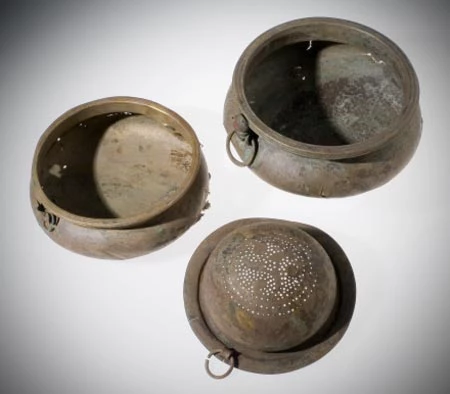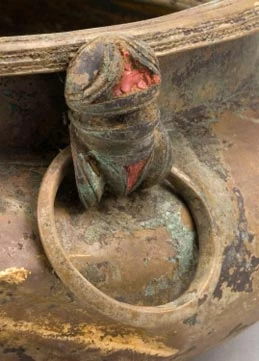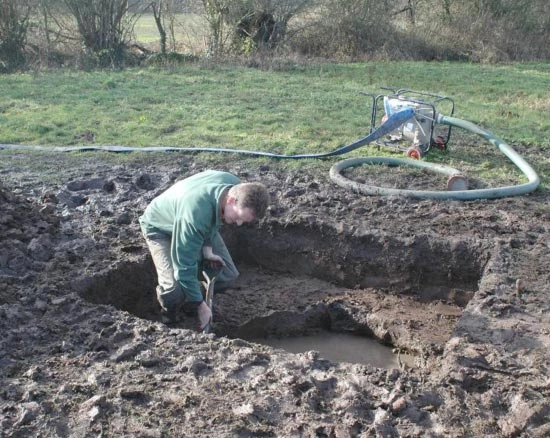Bowls in the Bog: the Langstone Treasure Revealed
The hoard group of two bowls and a wine-strainer
The decorated ring-handle fitting (escutcheon) on the large bowl
Investigating the waterlogged find-spot of the bowls and wine strainer. Undertaken as part of an ongoing treasure case by staff of the Portable Antiquities Scheme in Wales and of Amgueddfa Cymru — National Museum Wales
In December 2007, Craig Mills discovered two Late Iron Age bronze bowls and a bronze strainer, each decorated in the Celtic Art style. The finds were made while metal-detecting in a low-lying field near Langstone, Newport. This article presents these rare finds and shows how museum fieldwork and research are helping to tell their story...
The bronze vessels
This hoard of bowls with a 'wine-strainer' was once a drinking-set, for decanting and straining liquids. They may have been used for the preparation and drinking of newly fashionable Mediterranean wine. Alternatively, they may have been put to medicinal or religious use.
The bowls are round-bottomed with carefully formed rims. One is slightly larger than the other but the strainer sits comfortably in both. Each bowl has a decorated fitting below the rim, through which a ring was fitted for hanging and storage. The strainer has a wide brim and a rounded body with a ring for hanging. The base is decorated with a carefully designed strainer pattern, achieved by careful piercing with many small, circular holes. The perforation pattern forms three trumpet-shaped zones, surrounding a three-legged triskele motif. The triskele is an often repeated Celtic Art design on Iron Age metalwork in Wales.
The significance of the find
The two bronze bowls from Langstone were made during the Late Iron Age (50BC-AD60). Examples have previously been found across south western and south eastern England, sometimes in watery places and sometimes in graves. These, and another similar bowl fittings from Llantilio Crosseny (Monmouthshire), show that they were also used across south Wales. The Langstone discoveries provide a rare opportunity to follow up a recent discovery using modern archaeological techniques.
Wine-strainers of this form have previously been viewed as early Roman (AD75-150) in date, with examples known from Manorbier (Pembrokeshire) and Coygan (Carmarthenshire). However, this example, found with a set of Late Iron Age bowls, suggests they began to be made and used slightly earlier, probably between AD40-70.
Why were valued and complete vessels buried in a bog?
A few metres away from the hoard find-spot, a complete
wooden tankard of similar age was found at the same time. This suggested a place of particular significance, associated with drinking and the burial of drinking vessels.Two small test-pits were excavated by museum archaeologists and revealed the exact places of these finds, within the same peaty layer. The vessels had been carefully placed into the edge of a low-lying bog or shallow lake. Nearby, at the centre of this bog, on a slightly raised island of gravel, is a known Roman villa site. However, this remote island setting is unusual for a settlement. It may first have been selected as an isolated place of religious significance, before later becoming an important place of residence in Roman times.
Offerings to the gods
Burying prized objects in lakes, rivers and bogs was a widespread practice across north-western Europe during the Iron Age. These places were chosen for ceremonies involving the giving of prestigious items to the gods, who resided in these places. The reasoning for this final act of burial may relate to a moment of stress experienced by a local Iron Age community. During the middle of the 1st century AD, the Silures tribe of south Wales was engaged in bitter and prolonged conflict with an advancing Roman army. Perhaps such gifts reveal an urgent measure, a call on the power of the Celtic gods against an invading force.
Written by Adam Gwilt, with a contributing team of Evan Chapman, Mary Davis, Mark Lewis, Mark Lodwick, Craig Mills & Nigel Nayling


